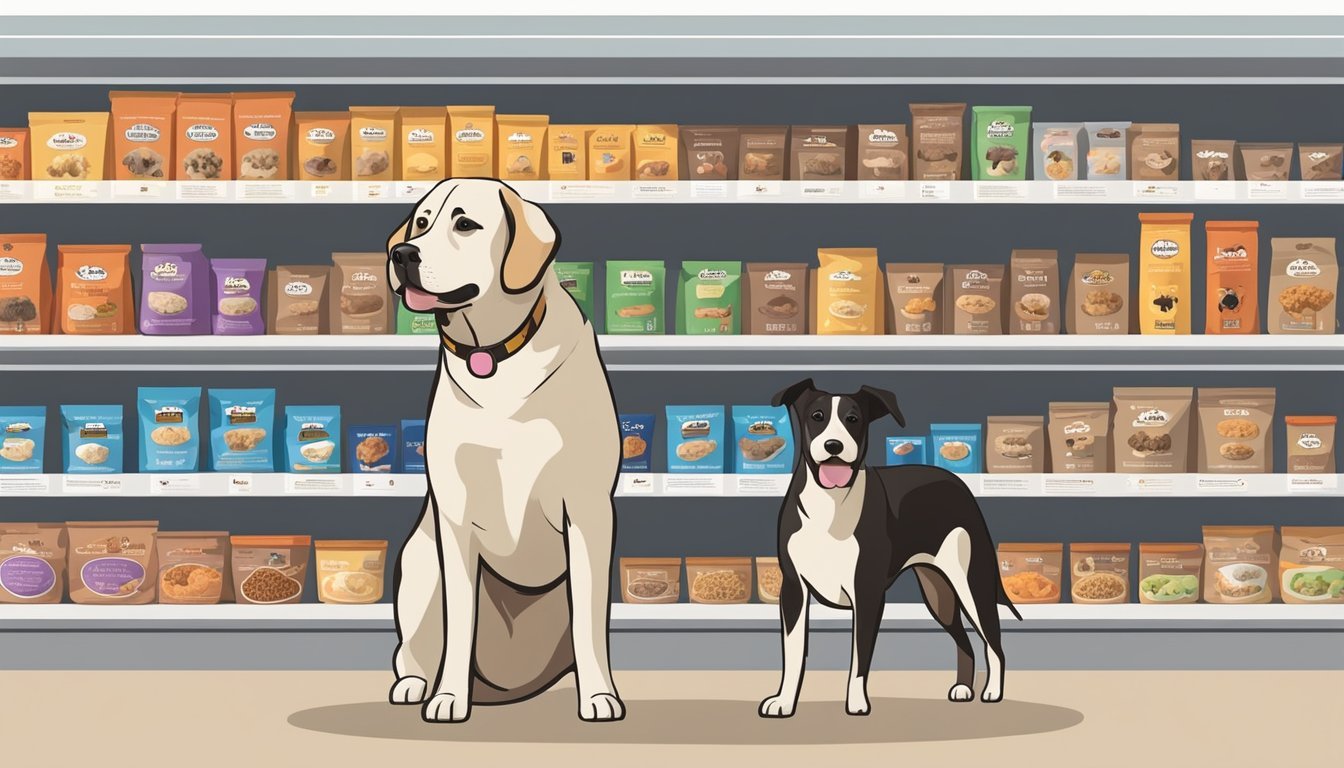Affordable Pet Essentials
Budget-Friendly Options for Pet Owners
Five Below, known for its affordable products, offers a surprising array of pet supplies including dog food options. While not a traditional pet store, Five Below provides budget-friendly choices for pet owners looking to save on essentials. The retailer's dog food selection includes basic dry kibble, treats, and portable feeding solutions for pet owners on the go.
Pet parents can find convenient items like gravity pet food dispensers and travel-friendly food and water containers at Five Below stores and online. These products cater to pet owners seeking practical solutions without breaking the bank. The store's offerings extend beyond just food, with accessories like elevated feeders and collapsible bowls also available.
While Five Below may not carry premium dog food brands, it serves as a viable option for pet owners needing affordable basics or travel supplies. The store's online presence and same-day delivery options through services like Instacart make it easy for customers to access Five Below's pet products quickly and conveniently.
Understanding Dog Nutrition
Proper nutrition is essential for a dog's health and wellbeing. A balanced diet supports growth, maintains body functions, and prevents health issues. Key factors include protein sources, carbohydrates, and fat content.
Dietary Needs by Dog Age
Puppies require more calories and protein than adult dogs. Their diet should contain at least 22% protein on a dry matter basis. Adult dogs need around 18% protein for maintenance.
Senior dogs often benefit from lower-calorie diets with easily digestible proteins. Age-specific formulas address changing nutritional needs as dogs grow older.
Pregnant and nursing dogs have increased calorie and nutrient requirements. Their food should be energy-dense and rich in protein to support fetal development and milk production.
Importance of Protein in Canine Diets
Protein is crucial for muscle development, tissue repair, and enzyme production in dogs. High-quality animal proteins like chicken, beef, fish, and turkey are highly digestible.
Plant-based proteins such as peas and nutritional yeast can supplement animal sources. However, they may not provide all essential amino acids dogs need.
The protein content in dog food should be at least 18% for adults and 22% for puppies. Active or working dogs may require higher protein levels to maintain muscle mass.
Carbohydrates and Dietary Fiber in Dog Food
Carbohydrates provide energy and aid in digestion. While not essential, they can be beneficial when properly balanced with other nutrients.
Grains like rice and oats are common carbohydrate sources in dog food. Grain-free options often use alternatives like sweet potatoes or lentils.
Dietary fiber supports digestive health and helps maintain healthy weight. It can come from both grains and vegetables in the dog's diet.
Moderate amounts of carbohydrates are generally appropriate for most dogs. The exact amount depends on the dog's activity level and overall health.
Evaluating Fat Content for Your Dog's Health
Fat is a concentrated energy source and helps absorb fat-soluble vitamins. It also contributes to skin and coat health.
Adult dogs typically need 5-15% fat in their diet. Puppies and very active dogs may require higher fat levels for growth and energy.
Omega-3 and omega-6 fatty acids are important for various bodily functions. Fish oil is a common source of these beneficial fats in dog food.
Overweight dogs may need lower-fat diets to help with weight management. However, extremely low-fat diets can lead to nutrient deficiencies and should be avoided.
Quality of Ingredients
The quality of ingredients in Five Below dog food plays a crucial role in your pet's nutrition and overall health. Careful examination of meat sources, understanding of meat meals and by-products, and awareness of preservatives used are key factors in assessing food quality.
Identifying High-Quality Meat Sources
High-quality dog food should list a specific meat as the first ingredient. Look for named meats like chicken, beef, or fish. Avoid generic terms such as "meat" or "animal protein." Whole meats provide essential amino acids and nutrients.
Imported meats may be subject to different quality standards. Check the origin of meat ingredients when possible. Some premium brands use locally-sourced meats to ensure freshness and quality control.
Meat content should be substantial. Higher percentages of meat typically indicate better quality food. However, exact percentages are rarely listed on labels.
Understanding Meat Meal and By-Products
Meat meal is a concentrated protein source made by rendering and dehydrating animal tissues. It contains more protein per weight than whole meat. Quality meat meals are labeled specifically, such as "chicken meal" or "lamb meal."
By-products include parts of animals not typically consumed by humans. These can be nutritious but vary in quality. Named by-products like "chicken by-products" are preferable to generic "animal by-products."
Some by-products provide valuable nutrients. Others may be less digestible. The nutritional value depends on the specific organs and tissues included.
Recognizing Common Preservatives
Preservatives extend the shelf life of dog food. Natural preservatives like vitamin E (mixed tocopherols) and vitamin C (ascorbic acid) are preferred options. These maintain freshness without potential health risks.
Artificial preservatives such as BHA, BHT, and ethoxyquin are sometimes used. While approved for use, some pet owners prefer to avoid these synthetic additives. Long-term effects of artificial preservatives are debated among experts.
Check the ingredient list for specific preservative names. Quality dog foods often use natural preservatives and clearly state their use on the label. Avoid products with unlisted or vague preservative information.
Food Selection by Dog Size and Breed
Proper nutrition is crucial for dogs of all sizes and breeds. Tailoring food choices to a dog's specific needs ensures optimal health and vitality.
Optimal Diets for Small Breeds
Small breed dogs have unique dietary requirements due to their fast metabolism and higher energy needs. They benefit from nutrient-dense foods with smaller kibble sizes for easier consumption. High-quality protein sources like chicken, fish, or lamb should make up 25-30% of their diet.
Small breeds often require more frequent meals throughout the day. Aim for 3-4 small portions to maintain stable blood sugar levels. Foods rich in omega-3 fatty acids support their coat health and reduce inflammation.
Consider age-specific formulas for small breeds. Puppies need extra calories and nutrients for growth, while senior dogs may require lower-calorie options to prevent weight gain.
Feeding Guidelines for Large Breeds
Large breed dogs have different nutritional needs compared to their smaller counterparts. They require diets with moderate protein and fat content to support lean muscle mass without promoting rapid growth, which can lead to joint issues.
Calcium and phosphorus levels should be carefully balanced in large breed puppy foods to ensure proper bone development. Adult large breeds benefit from glucosamine and chondroitin supplements for joint health.
Portion control is crucial for large breeds to prevent obesity. Divide their daily food intake into 2-3 meals. Slow-feed bowls can help prevent bloat, a common issue in large, deep-chested dogs.
Look for foods with high-quality, easily digestible ingredients to support their larger digestive systems. Large breed-specific formulas often include joint-supporting nutrients and controlled calorie content.
AAFCO Standards and Nutritional Adequacy
AAFCO, the Association of American Feed Control Officials, establishes guidelines for pet food nutrition. These standards help ensure that commercial dog foods provide complete and balanced nutrition.
The AAFCO nutritional adequacy statement appears on pet food labels. It indicates whether a product meets the nutritional needs of dogs at specific life stages.
To be labeled "complete and balanced," dog food must meet one of two criteria:
Pass feeding trials using AAFCO procedures
Meet AAFCO Dog Food Nutrient Profiles through laboratory analysis
AAFCO defines two main nutrient profiles:
Growth and reproduction
Adult maintenance
Pet owners should check the nutritional adequacy statement on dog food packaging. This information is typically found in small print on the back or side of the package.
The statement specifies which life stages the food is appropriate for. It may indicate if the product is suitable for all life stages or only for specific stages like adult maintenance.
AAFCO standards cover essential nutrients including proteins, fats, vitamins, and minerals. These guidelines aim to prevent nutritional deficiencies and support canine health.
When selecting dog food, consumers should look for products that meet AAFCO standards. This helps ensure their pets receive proper nutrition for their specific life stage and needs.
Choosing the Right Type of Dog Food
Selecting appropriate dog food is crucial for your pet's health and well-being. The two main types are dry kibble and wet canned food, each with distinct advantages.
Benefits of Dry Dog Food
Dry dog food offers several key advantages. It's convenient to store and serve, with a longer shelf life than wet food. Kibble helps maintain dental health by scraping plaque off teeth during chewing. Many dry foods are formulated with added nutrients and vitamins.
Dry food is typically more cost-effective per serving. It provides balanced nutrition in a compact form. Some brands offer grain-free options for dogs with sensitivities. Higher-quality dry foods often use real meat as the first ingredient.
Kibble comes in different sizes to suit various breeds. Larger pieces encourage slower eating, which can aid digestion. The crunchy texture satisfies dogs' natural chewing instincts.
Wet Food vs. Dry Food Comparison
Wet food has a higher moisture content, beneficial for dogs needing extra hydration. It's often more palatable, making it appealing to picky eaters. Canned food typically contains fewer preservatives than dry kibble.
Dry food is more energy-dense, requiring smaller portions. It's easier to measure and control calorie intake with kibble. Wet food can contribute to dental issues if it's the sole diet.
Mixing wet and dry food can offer a balance of benefits. This combination provides variety in texture and flavor. It allows for customization based on a dog's individual needs and preferences.
Some dogs may have wheat sensitivities, requiring grain-free options in both wet and dry varieties. Always consult with a veterinarian when choosing between food types for optimal nutrition.
Consumer Insights
Customer feedback and preferences play a crucial role in shaping the dog food market. Reviews provide valuable information about product quality and performance. Brand popularity often reflects consumer trust and satisfaction.
Reading and Understanding Reviews
Dog food reviews offer insights into product effectiveness and pet satisfaction. Many pet owners share detailed experiences about their dogs' reactions to different foods. Positive reviews often mention improved coat quality, increased energy levels, and better digestion. Negative feedback may highlight issues like palatability problems or allergic reactions.
To interpret reviews effectively, look for consistent themes across multiple sources. Pay attention to comments about ingredient quality, nutritional value, and long-term health effects. Be cautious of overly enthusiastic or extremely negative reviews, as they may not represent typical experiences.
Popular Brands and Consumer Choices
Several dog food brands have gained popularity among consumers. Purina, Royal Canin, and Merrick are frequently mentioned in discussions about quality pet nutrition. The Farmer's Dog has emerged as a popular fresh food option for those seeking alternatives to traditional kibble.
Consumers often prioritize factors like ingredient sourcing, nutritional balance, and value for money when selecting dog food. Many pet owners are increasingly interested in grain-free options and foods tailored to specific breeds or health needs. Price points vary widely, with some premium fresh food plans starting around $2-3 per day for small dogs.
Brand loyalty in dog food is common, with many consumers sticking to products that have worked well for their pets. However, an increasing number of pet owners are willing to experiment with new brands based on positive reviews and recommendations.







